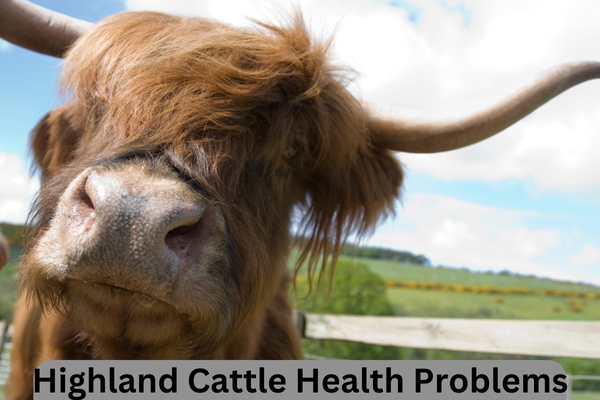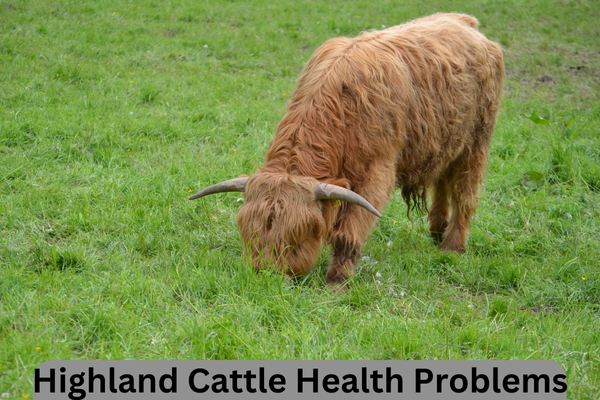Highland Cattle Health Problems
Highland cattle are a popular Scottish breed known for their long, wavy coats and majestic horns. While generally hardy, they can be susceptible to certain health conditions. Being aware of potential Highland cattle health problems can help breeders and farmers properly care for their herd.
In this blog article, we will cover the most common Highland cattle diseases, illnesses, and medical issues these cattle face.
Common Infectious Diseases in Highland Cattle
Like all cattle breeds, Highlanders are at risk for contracting certain infectious diseases. Some of the most prevalent contagious illnesses in Highland cattle herds include:
1. Bovine Viral Diarrhea (BVD) – A viral gastrointestinal infection spread through body fluids that causes diarrhea, fever, weakened immunity, and more. Testing, vaccination, and biosecurity practices help control BVD outbreaks.
2. Infectious Bovine Rhinotracheitis (IBR) – A respiratory virus in cattle characterized by fever, runny nose and eyes, coughing, and breathing issues. The IBR virus is easily spread and vaccination is recommended.
3. Parasitic Infections – Highland cattle graze extensively, putting them at high risk for parasites like lungworm, fluke, and intestinal worms. Strategic deworming and pasture management prevents parasitic disease.
4. Pinkeye (Infectious Bovine Keratoconjunctivitis) – A contagious bacterial infection of the eye caused by face flies, featuring inflammation, eye discharge, squinting, and light sensitivity. Controlling flies and prompt treatment prevents spread.
Common Metabolic & Nutritional Disorders
Highland cows can also face certain metabolic and nutritional disorders, including:
1. Milk Fever – Also called postpartum hypocalcemia, milk fever is a deficiency of calcium levels after calving, causing weakness, tremors, and recumbency. Providing dietary calcium prevents milk fever.
2. Acidosis – Overeating grains causes a rapid drop in rumen pH, resulting in acidosis. Symptoms include going off feed, diarrhea, dehydration, and laminitis. Gradual grain introduction prevents acidosis.
3. Bloat – The dangerous accumulation of gas in the rumen, causing the abdomen to swell. Bloat can be fatal quickly without emergency treatment. Avoiding legumes, sudden diet change, and monitoring cattle prevents bloat.

Common Reproductive Issues
Reproductive issues can significantly impact Highland cattle fertility and calving rates. Some key reproductive problems in Highlands include:
1. Dystocia – Abnormal or difficult calving often requiring human assistance. Dystocia has many causes like calf malposition, small pelvic area, uterine inertia, twins, and calf defects. Proper nutrition and bull selection reduces calving issues.
2. Retained Placenta – Failure to expel fetal membranes after calving, causing infection risk. Supporting calcium intake, reducing calving stress, and manual removal resolve most retained placentas.
3. Metritis – A postpartum uterine infection typically from retained placenta material causing fever, appetite loss, and reduced milk. Antibiotics and uterine flushes treat metritis.
Common Congenital & Inherited Disorders
Certain congenital and inherited disorders can impact Highland cattle health, including:
1. Contractural Arachnodactyly – An inherited connective tissue disorder causing leg, joint, and hoof defects. Avoid breeding carrier animals to prevent this disorder.
2. Polycystic Kidney Disease (PKD) – An inherited renal disorder featuring fluid-filled cysts that impair kidney function. PKD is fatal and widespread in the Highlands. Genetic testing identifies carrier animals.
3. Inherited Hypotrichosis (Hairlessness) – A rare congenital absence of hair due to genetic mutation. Hairless Highland calves rarely survive long due to health complications. Do not breed carrier parents.
Common Injuries & Physical Disorders
As a rugged breed living in mountainous terrain, Highland cattle also face certain physical conditions, including:
Lameness – Abnormal gait or posture due to hoof infections, arthritis, trauma, or musculoskeletal disorders. Hoof trimming/treatment and physical therapy aid recovery.
2. Lacerations – Deep cuts from barbed wire fencing or equipment. Major lacerations require wound cleaning, antibiotics, stitches, and tetanus vaccines for optimal healing.
3. Brisket Disease – Pulmonary hypertension from grazing at high elevations, causing labored breathing, exercise intolerance, and fluid accumulation. Bringing cattle to lower elevations reverses symptoms.
4. Pinkeye scars – Permanent eye clouding or blindness from recurrent pinkeye infections. Scars do not affect cattle health but lower market value. Fly control prevents scarring.

Preventing Highland Cattle Health Problems
While Highland cattle are generally quite hardy due to evolving in the harsh Scottish Highlands, they can still be susceptible to certain health conditions. Implementing proactive preventative health measures is key to maintaining optimal wellness and productivity within a Highland cattle herd.
Follow Strict Biosecurity Protocols
Biosecurity refers to precautions taken to reduce the risk of infectious disease introduction and spread. Strong on-farm biosecurity remains the cornerstone of disease prevention in cattle. For Highland cattle operations, key biosecurity best practices involve:
- Quarantining all incoming cattle in a separate pasture for 30-60 days before introducing to the herd
- Requiring health certificates and recent lab test results from the source farm before acceptance
- Monitoring the herd daily for signs of emerging illness
- Cleaning and disinfecting equipment, trailers, boots, etc. between use with different groups of cattle
- Establishing perimeter fencing, gates, and buffers between neighboring livestock
- Preventing contact with other cattle breeds at shows or events when possible
Following rigorous protocols minimizes contagious respiratory, reproductive and other Highland cattle illnesses. Work closely with your veterinarian to develop targeted biosecurity strategies.
Provide Optimal Nutrition & Prevent Metabolic Disorders
While able to thrive on poor-quality forage, Highland cattle still require balanced nutrition to remain healthy. Work with a cattle nutritionist to formulate age-appropriate diets.
Monitor body condition scoring regularly. Supply proper macro and micronutrients during key phases like breeding, gestation and lactation.
Prevent common nutritional disorders like bloat, milk fever, acidosis and selenium deficiency through strategic supplementation when warranted.
Ensure constant access to clean water and salt/mineral sources. Rotate pastures and run soil tests periodically. Proper nutrition helps prevent weakness, illness and bolsters immunity.
Deworm Strategically & Control Pests
Given their extensive grazing, Highland cattle face heavy parasite and pest loads if not controlled. Work with your veterinarian to implement a strategic deworming protocol using livestock parasite diagnostics and rotating dewormer drug classes to prevent resistance. Limit cattle access to swampy areas harboring snails spreading liver fluke.
Use dust bags, back rubbers and spray livestock insecticide to combat face flies, lice and other external parasites that spread pinkeye, skin infections and make cattle more susceptible to disease overall. Maintain fencing and provide windbreaks/shelters to protect cattle from biting insects.
Vaccinate Against Major Viral Diseases
Vaccinating breeding cattle and calves against common viral pathogens remains crucial. Highland cattle vaccines may include:
- IBR (rednose), BVD (scours), BRSV (shipping fever pneumonia), leptospirosis
- 7-way clostridials (blackleg, tetanus, enterotoxemia)
- Pinkeye, rabies
Booster vaccines at prescribed intervals to maintain immunity levels. Properly store and administer vaccines to ensure effectiveness. Time vaccine administration to allow immunity development prior to greatest disease risk – consult your veterinarian. Combine vaccination and handling to minimize stress.
The above preventative health measures require an investment of time and resources. However the cost pales in comparison to that of treating widespread illness or losing cattle.
Protecting the health of a Highland cattle herd allows it to thrive for generations. Work closely with bovine veterinary health experts to tailor the optimal disease prevention regime for your cattle operation.
Conclusion;
By taking proactive steps to monitor and safeguard herd health, Highland cattle breeders and farmers can help their Scottish cattle thrive for generations to come. Paying attention to common Highland health problems remains key to reducing morbidity and mortality rates within the herd.
Work closely with your local large animal veterinarian to develop the most optimal herd health protocol for your Highland cattle operation.


